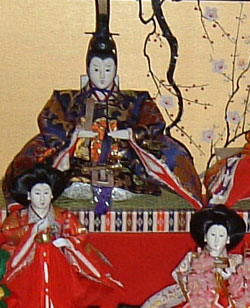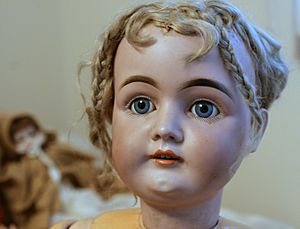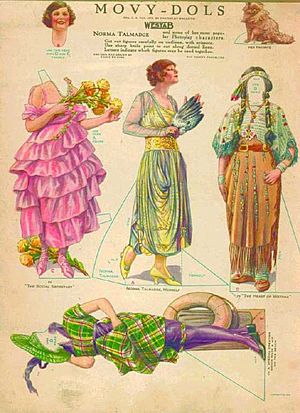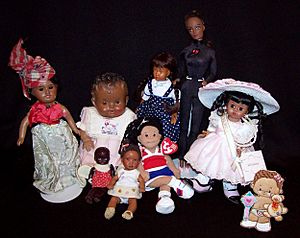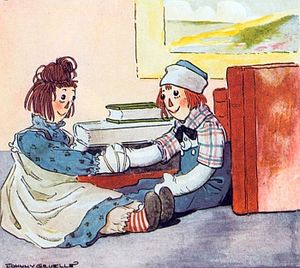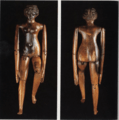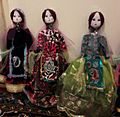Doll facts for kids
A doll is a toy that looks like a baby or another person. Dolls have been around for a very long time, since humans first started living in groups. They have been made from many different things like stone, clay, wood, cloth, and even plastic.
While dolls are usually for children, adults also collect them. They might collect dolls to remember things from the past, because they are beautiful, or because they are historically important. Some old dolls can be worth a lot of money! In ancient times, dolls were sometimes used as symbols of gods or goddesses in religious ceremonies. Today, artists sometimes use special jointed wooden figures to help them draw the human body.
There are many kinds of dolls. Action figures, which look like superheroes or military people, are very popular with boys. Other popular dolls include baby dolls, paper dolls, and fashion dolls. The list goes on and on!
Contents
The History of Dolls
Early Dolls and Traditional Dolls
The first dolls were made from materials found nearby, like clay, stone, wood, bone, or wax. Experts who study old things (archaeologists) believe dolls might be the oldest toys ever. Wooden paddle dolls have been found in ancient Egyptian tombs from over 4,000 years ago. Dolls with arms and legs that could move, and clothes that could be taken off, existed at least 200 years before Christ.
Ancient Greek dolls were made of clay and could move at the hips and shoulders. Stories from ancient Greece show that little girls played with dolls around 100 AD. In Rome, dolls were made of clay, wood, or ivory. Dolls have been found in the graves of Roman children. Just like kids today, Roman children would dress their dolls in the latest fashions. When Greek and Roman girls got married, they would give their dolls to a goddess.
Rag dolls are traditionally made at home from leftover pieces of cloth. Roman rag dolls have been found from as far back as 300 BC.

Traditional dolls are sometimes used as toys, but they can also be important for spiritual or magical reasons. It is not always clear where the line is between a spiritual doll and a toy. In some cultures, dolls used in special ceremonies were later given to children. They were also used to teach children and pass on cultural traditions. In other cultures, dolls were thought to have too much magical power for children to play with them.
African dolls are used for teaching and fun. They can also be seen as a way to connect with spirits or used in rituals. Their look and clothes change depending on the region and customs. Dolls are often passed down from mothers to daughters. Akuaba are wooden dolls from Ghana used in rituals to encourage fertility (having children). The most famous akuaba are from the Ashanti people, and they have large, flat, disc-like heads.
There is a long history of Japanese traditional dolls. This goes back to the Dogū figures (8000–200 BC) and Haniwa figures (300-600 AD) found in tombs. By the 11th century, dolls were used for play, protection, and religious ceremonies. During Hinamatsuri, the doll festival, special hina dolls are displayed. These dolls are made of straw and wood, painted, and dressed in fancy, layered clothes.
Daruma dolls are round dolls with red bodies and white faces without pupils (the black part of the eye). They represent Bodhidharma, who started Zen Buddhism, and are used as good luck charms. Wooden Kokeshi dolls have no arms or legs, but a large head and a cylinder-shaped body. They represent little girls.
Some cultures used dolls to represent a person for magic rituals. These include the European poppet and the nkisi or bocio from West and Central Africa. In European folk magic, poppet dolls were used to cast spells. People believed that whatever happened to the doll would happen to the person it represented. The idea of sticking pins in voodoo dolls is often linked to African-American Hoodoo folk magic. However, voodoo dolls are not really part of the Haitian Vodou religion. This idea mostly comes from movies and stories. A kitchen witch is a doll from Northern Europe that looks like a witch. It is displayed in kitchens for good luck and to keep away bad spirits.
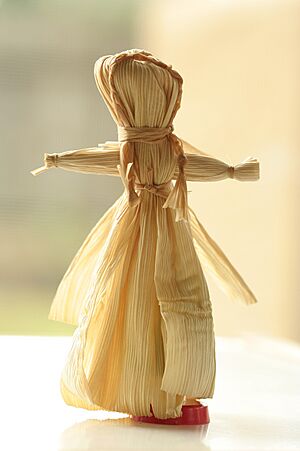
Hopi Kachina dolls are figures made of cottonwood. They represent the masked spirits of the Hopi Native American tribe. Kachina dolls are meant to be studied to learn about each spirit. Inuit dolls are made from soapstone and bone, materials common to the Inuit people. Many are dressed in animal fur or skin, showing traditional clothes needed for cold winters. The tea dolls of the Innu people were filled with tea for young girls to carry on long trips.
Apple dolls are traditional North American dolls with heads made from dried apples. Corn husk dolls are traditional Native American dolls made from the dried leaves of a corncob. They usually do not have a face. Early European settlers in the United States also started making corn husk dolls. They also made rag dolls and carved wooden dolls called Pennywoods.
"La última muñeca" (the last doll) is a tradition in some parts of Latin America during a girl's Quinceañera (her 15th birthday celebration). During this ritual, the girl gives up a doll from her childhood. This shows she is no longer a child who needs such a toy. In the United States, doll making became a big industry in the 1860s, after the Civil War.

Matryoshka dolls are traditional Russian dolls. They are a set of hollow wooden figures that fit inside each other. They usually show traditional peasants. The first set was made in 1890. In Germany, clay dolls have been around since the 13th century, and wooden dolls since the 15th century.
From about the 15th century, more detailed dolls were made for Nativity scenes, especially in Italy. Dolls with fancy, fashionable clothes were sold in France in the 16th century. German and Dutch peg wooden dolls were cheap and simple. They were popular toys for poorer children in Europe from the 16th century onwards. Wood was the main material for dolls in Europe until the 19th century. Later, wood was mixed with other materials like leather, wax, and porcelain. Dolls also became more movable. It is not known when dolls first got glass eyes. Brown was the most common eye color until the Victorian era, when blue eyes became more popular, inspired by Queen Victoria.
Dolls, puppets, and masks allow people to express things that might be difficult to say in real life. For example, in Iran during the Qajar era, people used puppets to criticize politics without fear of punishment. In some cultures, dancing in public, especially for women, is not allowed. But dolls or puppets can dance freely. Layli (Lurish doll) is a dancing doll popular among the Lur people of Iran. Layli is a symbol of spiritual beauty and helps keep a cultural tradition alive.
Stargazer Lottie Doll was the first doll to go into space! She traveled with British ESA Astronaut Tim Peake. Lottie stayed on the International Space Station for 264 days. She was designed by a 6-year-old girl from Canada who wanted to get kids interested in space.
Dolls in the Industrial Era
During the 19th century, doll heads were often made of porcelain. Their bodies were made of leather, cloth, wood, or mixed materials like papier-mâché. With the invention of polymer and plastic materials in the 20th century, doll making mostly switched to these. Plastic was cheap, easy to make, and strong. This meant new types of dolls could be made in large numbers at a lower price. Early plastic-like materials included rubber and celluloid. From the mid-20th century, soft vinyl became the main material for children's dolls.
Sometimes people use the words porcelain doll, bisque doll, and china doll to mean the same thing. But collectors know the difference. China dolls are made of glazed porcelain, which means they have a shiny finish. Bisque dolls are made of unglazed porcelain, so they have a matte (not shiny) finish that looks like skin. An old china doll usually has a white, shiny porcelain head with painted hair and a body made of cloth or leather. They were made in huge numbers in Germany between 1840 and 1890. Parian dolls were also made in Germany from 1860 to 1880. They are like china dolls but their heads are not shiny. Bisque dolls were very popular between 1860 and 1900, especially French and German ones. Old bisque dolls were often toys, but today, bisque dolls are mostly made for adult collectors.
Until the mid-19th century, most European dolls looked like grown-ups. Dolls that looked like children or babies did not appear until around 1850. But by the late 19th century, baby and childlike dolls were everywhere. Lifelike wax dolls were popular in Victorian England.
Paper dolls are cut out of paper, with separate clothes that attach with folding tabs. They often show current fashion styles. Paper dolls of 19th-century ballerinas were some of the first dolls based on famous people. The 1930s Shirley Temple doll sold millions and was one of the most successful celebrity dolls ever. Small celluloid Kewpie dolls were popular in the early 20th century. Madame Alexander made the first collectible doll based on a character from a movie – Scarlett O'Hara from Gone with the Wind.
Modern dollhouses come from European "baby house" display cases from the 17th century. Early dollhouses were all handmade. But after the Industrial Revolution and World War II, they were made in factories and became more affordable. Children's dollhouses in the 20th century were made of tin, plastic, and wood. Today, dollhouses for adult collectors are usually made of wood.
The first modern stuffed toys were made in 1880. They are different from older rag dolls because they are made of soft, furry fabric and usually look like animals, not humans. Teddy bears first appeared in 1902-1903.
Black dolls are designed to look like people with dark skin. Rag dolls made by enslaved people in America were toys for their children. The Golliwogg was a rag doll character from a children's book in the late 19th century. It was widely made into a toy. This doll had very black skin, white-rimmed eyes, and frizzy hair. It has been described as a harmful stereotype. Early factory-made black dolls were often just dark versions of white dolls. The first American black dolls with realistic African features were made in the 1960s.
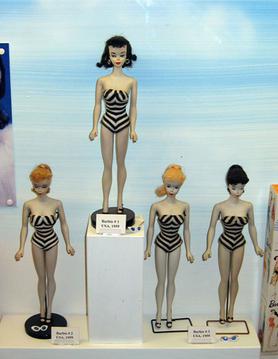
Fashion dolls are mainly designed to be dressed in trendy clothes. They usually look like teen girls or adult women. The first fashion dolls were French bisque dolls from the mid-19th century. Today, fashion dolls are usually made of vinyl. Barbie, from the American toy company Mattel, was the most popular fashion doll since she was created in 1959. Bratz was the first doll to really challenge Barbie's popularity, taking a large part of the market by 2006.
Plastic action figures, often looking like superheroes, are very popular with boys. Fashion dolls and action figures are often part of a larger story world (a media franchise). This can include movies, TV shows, video games, and other related items. Bobblehead dolls are collectible plastic dolls with heads that bobble because they are connected to the body by a spring. They often look like baseball players or other athletes.
With computers and the Internet, virtual and online dolls appeared. These are often like traditional paper dolls. Users can design virtual dolls and drag and drop clothes onto them. Examples include KiSS, Stardoll, and Dollz.
The Internet also made it easier to customize and sell collectible dolls online. Reborn dolls are vinyl dolls that are changed to look as much like a real human baby as possible. They are often sold online. Asian ball-jointed dolls (BJDs) are made of synthetic resin. They look both realistic and like characters from anime. Asian BJDs and Asian fashion dolls like Pullip and Blythe are often customized and photographed. The photos are shared in online groups. Now, custom dolls can even be designed on computers and then made using 3D printing.
How Dolls Are Used and What They Look Like
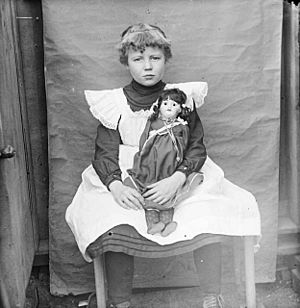
For thousands of years, dolls have been important in magic and religious ceremonies. They have also been used to represent gods. Dolls have always been traditional toys for children. Adults also collect dolls for many reasons: because they bring back memories, because they are beautiful, because they are historically important, or because they are worth money. Old dolls that were once children's toys are now valuable collector's items. For example, 19th-century bisque dolls from French makers like Bru and Jumeau can be worth almost $22,000 today.
Dolls have been made as simple toys and also as very detailed works of art. They have been created as folk art in cultures all over the world. In the 20th century, special art dolls began to be seen as fine art. Artist Hans Bellmer made surrealistic dolls with parts that could be swapped. He did this in the 1930s and 1940s in Germany to protest against the Nazi party's focus on a "perfect" body.
Lifelike dolls are used by doctors, nurses, and social workers to train them in different health procedures. Artists sometimes use jointed wooden figures to help them draw the human body.
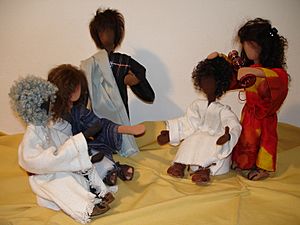
Egli-Figuren are a type of doll that started in Switzerland in 1964. They are used for telling Bible stories.
In Western society, boys and girls often choose different types of toys. Action figures, which show traditional masculine traits, are popular with boys. Boys often choose toys related to tools, transportation, machines, and military equipment. Dolls for girls often show feminine traits and come with things like clothing, kitchen items, and jewelry.
Pediophobia is a fear of dolls or similar objects. Some experts believe that strange feelings happen when we are not sure if an object is alive or not. This idea led to the "uncanny valley" theory. This theory suggests that if an object looks almost human, but not quite, it can seem disturbing instead of appealing.
Doll Hospitals
A doll hospital is a special workshop that fixes or restores dolls. You can find doll hospitals in many countries. One of the oldest was opened in Lisbon, Portugal, in 1830. Another in Melbourne, Australia, started in 1888. There is even a Doll Doctors Association in the United States. Henri Launay, who has been fixing dolls in Paris for 43 years, says he has restored over 30,000 dolls! Most of his customers are adults, not children. Some doll brands, like American Girl and Madame Alexander, also offer repair services for their own dolls.
Dolls in Children's Stories
Many books feature dolls. For example, Wilhelmina. The Adventures of a Dutch Doll by Nora Pitt-Taylor. Rag dolls have appeared in many children's stories, such as the 19th-century character Golliwogg in The Adventures of Two Dutch Dolls and a Golliwogg. Another famous rag doll is Raggedy Ann in the books by Johnny Gruelle, first published in 1918. The Lonely Doll is a 1957 children's book by Canadian author Dare Wright. It tells the story of a doll named Edith and two teddy bears through text and photos.
Images for kids
-
The doll of Crepereia Tryphaena, from Rome, second century AD
-
A traditional Native American Hopi Kachina doll, probably late 19th century
-
Layli dolls from Mamasani, Iran
See also
 In Spanish: Muñeca para niños
In Spanish: Muñeca para niños



